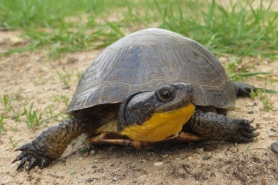Herptile Regulations
All native herptiles (herps) are considered protected and have some level of protection. An overview of state regulations related to amphibians and reptiles can be found in Wisconsin's Amphibian and Reptile Regulations.
For any planned land-disturbing activities, an Endangered Resources Review should be conducted before beginning the project to ensure that there will not be any impacts on rare species and that planned activities are in compliance with Wisconsin’s Endangered Species Law (s. 29.604 Wis. Stats.), as well as other laws about rare species.
Activity periods
If your Endangered Resources Review has required or recommended timing restrictions, please use the table below to help with your follow-up actions.
| Species | Fall Activity (2025) |
|---|---|
| Blanchard’s cricket frog | Blanchard’s cricket frogs are currently inactive. |
| Blanding's turtle | Blanding’s turtles are currently inactive. |
| Butler’s gartersnake | Butler’s gartersnakes are currently inactive. |
| Eastern massasauga rattlesnake | Eastern massasauga rattlesnakes are currently inactive. |
| Eastern ribbonsnake | Eastern ribbonsnakes are currently inactive. |
| Ornate box turtle | Ornate box turtles are currently inactive. |
| Queensnake | Queensnakes are currently inactive. |
| Slender glass lizard | Slender glass lizards are currently inactive. |
| Timber rattlesnake | Timber rattlesnakes are currently inactive. |
| Western ribbonsnake | Western ribbonsnakes are currently inactive. |
| Wood turtle | Wood turtles are currently inactive. |

